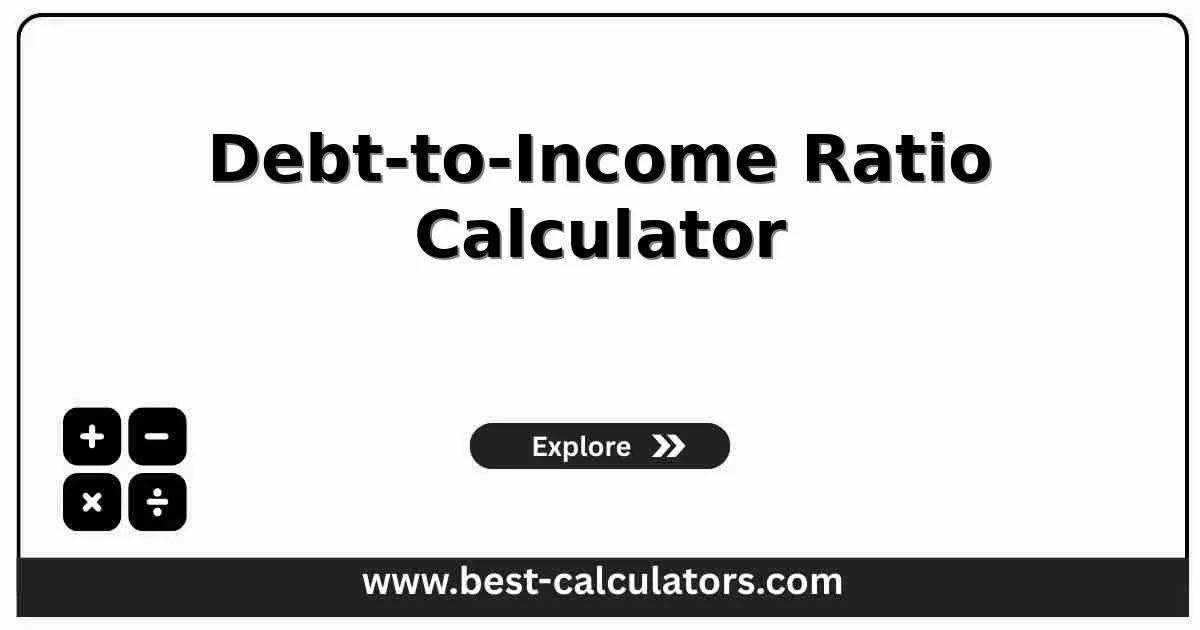Debt-to-Income Ratio Calculator - Calculate DTI
Free DTI calculator to assess mortgage qualification and financial health. Calculate debt-to-income ratio, front-end and back-end ratios with 2025 standards
DTI Calculator
Results
What is Debt-to-Income Ratio?
Debt-to-Income (DTI) ratio is a financial metric that compares your total monthly debt payments to your gross monthly income. It's expressed as a percentage and is one of the most important factors lenders use to assess your ability to manage monthly payments and repay borrowed money.
DTI ratio helps lenders evaluate:
- Mortgage qualification - Whether you can afford a home loan
- Creditworthiness - Your ability to manage debt responsibly
- Financial health - Overall balance between income and debt
- Loan terms - Better DTI often means better interest rates
- Borrowing capacity - Maximum loan amount you can qualify for
Understanding your DTI is crucial for home buying. Use our house affordability calculator to determine how much home you can afford based on your income and debt levels.
Once you know your DTI and home budget, our mortgage calculator can help you estimate your complete monthly payment including principal, interest, taxes, and insurance.
If your DTI is too high, consider using our debt payoff calculator to create a strategic plan for reducing your debt and improving your qualification chances.
How DTI Ratio Works (28/36 Rule)
The 28/36 rule is the traditional lending standard that lenders use to evaluate mortgage applications:
28% Front-End Rule
Your monthly housing costs should not exceed 28% of your gross monthly income. This includes mortgage payment, property taxes, insurance, and HOA fees.
36% Back-End Rule
Your total monthly debt payments should not exceed 36% of your gross monthly income. This includes housing costs plus all other debt obligations.
Formula:
Front-End DTI = (Monthly Housing Costs / Gross Monthly Income) × 100
Back-End DTI = (Total Monthly Debt Payments / Gross Monthly Income) × 100
Example: With $6,000 monthly income, $1,850 in housing costs, and $700 in other debt:
Front-End DTI = ($1,850 / $6,000) × 100 = 30.8%
Back-End DTI = ($2,550 / $6,000) × 100 = 42.5%
Key Concepts
Front-End DTI (Housing Ratio)
Only includes housing-related expenses: mortgage/rent, property taxes, homeowners insurance, and HOA fees. Ideal: ≤28%.
Back-End DTI (Total Debt Ratio)
Includes all monthly debt: housing costs plus car loans, student loans, credit cards, personal loans, and other recurring debt. Ideal: ≤36%.
2025 Qualification Limits
Conventional loans: 43-50% max DTI. FHA loans: up to 50-57% with compensating factors. Best rates: 36% or lower.
How to Use This Calculator
Enter Monthly Income
Input your gross monthly income before taxes and deductions (e.g., $6,000)
Enter Housing Costs
Input mortgage/rent, property tax, insurance, and HOA fees
Enter Other Debt
Add car loans, student loans, credit card payments, and other monthly debt
Review Your Ratios
View front-end DTI (housing) and back-end DTI (total debt)
Check Qualification
See your qualification status based on 2025 lending standards
Plan Improvements
Use results to identify areas for debt reduction or income growth
Benefits of Using DTI Calculator
- • Mortgage Readiness: Know if you qualify for a home loan before applying and avoid wasted time.
- • Financial Planning: Understand how much debt you can comfortably manage with your income.
- • Debt Management: Identify if you need to pay down debt before major purchases.
- • Better Loan Terms: Lower DTI often qualifies you for better interest rates and loan terms.
- • Strategic Planning: Make informed decisions about taking on new debt or increasing income.
How to Improve Your DTI
1. Reduce Monthly Debt Payments
Pay off credit cards, consolidate loans, or refinance high-interest debt to lower monthly obligations.
2. Increase Your Income
Ask for a raise, take on side work, or add a co-borrower to increase total household income.
3. Avoid Taking On New Debt
Don't finance major purchases or open new credit cards before applying for a mortgage.
4. Make a Larger Down Payment
A bigger down payment reduces your mortgage amount, lowering your front-end DTI ratio.

Frequently Asked Questions (FAQ)
Q: What is a good DTI ratio?
A: A good DTI ratio is typically 36% or less. Lenders prefer front-end DTI under 28% and back-end DTI under 36% (the 28/36 rule). DTI ratios above 43% may make it difficult to qualify for most mortgages.
Q: What is front-end vs back-end DTI?
A: Front-end DTI only includes housing costs divided by income. Back-end DTI includes all monthly debt payments (housing plus other debt) divided by income. Lenders evaluate both.
Q: What DTI do I need for a mortgage?
A: Most conventional mortgages require back-end DTI of 43% or less, though some allow up to 50%. The ideal range is 28% front-end and 36% back-end for best loan terms.
Q: Does DTI include utilities?
A: No, DTI does not include utilities or living expenses. It only includes recurring debt: housing costs, car loans, student loans, credit cards, and other debt with monthly payments.